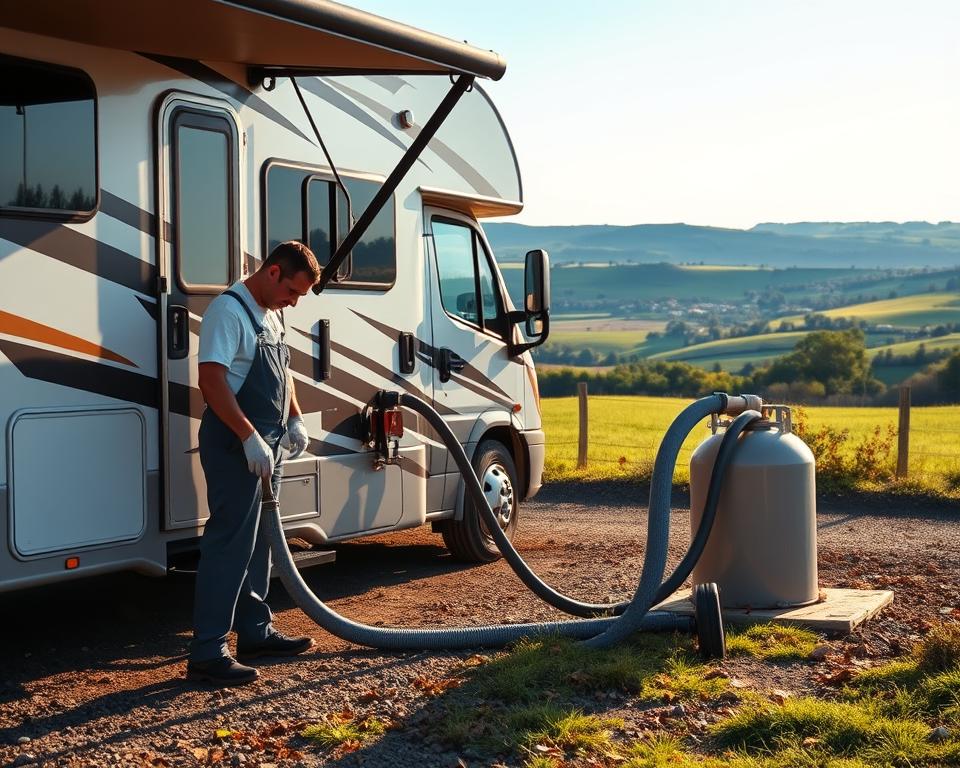RV Sewage Tank Pumping: Key Upkeep Guidelines
Consider the consequences of neglecting your RV’s septic system. Numerous campers feel intimidated by tank draining. However, understanding these upkeep steps is essential. Such measures keep your trips worry-free and prevent costly fixes. Mastering correct waste handling is fundamental to your system’s longevity. Here are key pointers on RV sewage pump with upkeep advice to ensure your system operates flawlessly.
Getting to Know Your RV’s Waste Setup
Every recreational vehicle features a septic setup. It consists of a black tank for toilet use, a gray tank for sinks/showers, plus a freshwater reservoir. Knowing these components prevents clogs and ensures efficient cleaning.
Drains and vents manage liquid and air movement throughout the system. Understanding this synergy helps you avoid blockages and buildup. This knowledge ensures hassle-free trips and reliable waste handling.
Regular checks and care keep your tanks in top shape. Monitoring fill levels and dumping when needed keeps odors at bay. By maintaining your RV’s septic system properly, you’ll improve its lifespan and enjoy every trip more.
Importance of Regular RV Septic Tank Pumping
Routine sewage draining preserves functionality and hygiene. Waste buildup triggers odors and backups that ruin outings. Overfilled tanks risk ugly overflows. Such mishaps kill the fun on the road.
Skipping pump-outs leads to pricey repairs. System failures cause leaks and wear out parts prematurely. Timely emptying keeps your plumbing running smoothly. It prevents unwelcome surprises and roadside emergencies.
Staying on top of maintenance wards off backups. Investing in pump-outs shows you care about your RV. Your trips become more relaxing. A strict pumping routine lets you enjoy camping without septic concerns.
Finding the Right Dump Frequency
Determining dump intervals needs careful thought. Generally, dump every 3–5 days when in use. However, it shifts based on tank volume and number of users. Pinpointing the correct dump time is key for effective wastewater management.
Empty once the black tank reaches roughly 66% full. It ensures good drainage and cuts down on odors. Ignoring it can cause backups and unpleasant odors.
Various factors influence dump frequency, such as
- Number of people on board
- Length of stay
- Type of waste generated
- Tank capacity
Scheduling prevents on-the-road crises. Sync with any public dump station hours. Knowing your patterns predicts when to dump.
| Usage Scenario | Pumping Frequency |
|---|---|
| Short Trip, Two Campers | Every 3–4 days |
| Extended Trip (4–6 people) | Every 2–3 days |
| Seasonal Use, Two to Four Campers | Weekly or Bi-Weekly |
Monitor fill levels and usage patterns. This proactive stance ensures enjoyable travel.

Best Practices for Dumping Your Tanks
Correct dumping preserves system health and prevents issues. Always empty the black tank first to protect the gray tank. It keeps gray water from mixing with solids.
Using a high-quality hose minimizes leaks and ensures smooth dumping. Tighten connections to stop spills. After emptying, flush the black tank with plenty of water. This removes residue and preps the tank for next time.
Know where dump stations are located. Being prepared saves time on the road.
In short, follow these key steps for efficient dumping:
- Empty the black water tank first.
- Use a top-quality sewer hose.
- Flush the black tank thoroughly after emptying.
- Plan your dump station locations.
Following these guidelines simplifies black tank maintenance.
Proper Use and Maintenance of Your RV Tanks
Grasping correct handling of black and gray tanks ensures system health. Maintain a bit of water in the black tank to aid waste decomposition.
Refrain from disposing non-biodegradable items. Always use RV-safe toilet paper to prevent clogs. Inspect tanks often to catch problems early.
Adding treatments now and then improves septic service. These products balance enzymes and bacteria for efficient decomposition. Simple steps ensure smooth tank operation.
- Check for leaks and damage often.
- Apply RV-specific chemical treatments.
- Keep vents clear to avoid odors.
Adhering to these practices safeguards your system. It also boosts your camping enjoyment.
Essential Pumping Tips
Successful pumping requires precision and a clear procedure. It’s essential to use designated dump stations. Understanding volume limits prevents spills on the go.
Check tank indicators regularly to time pump-outs. This extends tank life and enhances trip comfort. Setting a dumping schedule improves system efficiency.
Flush well after every emptying. It ensures each dump is cleaner than the last. Such tactics keep your rig in top shape and improve your travel experiences.
Typical RV Septic Pitfalls
Maintaining your system is vital for uninterrupted camping. Not using enough water in the black tank leads to buildup. Proper flushing dissolves waste better.
Flushing inappropriate items blocks pipes. Avoid non-dissolvable products like feminine hygiene items. Such mistakes can damage plumbing and inflate repair bills.
Keep the black tank valve closed until ready to dump. Premature opening prevents a full flush. This ensures solids clear on each dump.
Knowing these pitfalls helps maintain efficiency. Avoiding them keeps your waste management reliable.
When to Call in Professional RV Waste Disposal Services
Knowing when to hire pros preserves system health. Persistent odors often indicate complex issues. Slow drains point to potential clogs or buildup.
Visible residue at dump points requires attention. Such situations usually need high-pressure cleaning. Pros blast away blockages to restore smooth flow.
Regular expert check-ups safeguard tank health. Early intervention avoids expensive failures. Professional service ensures proper functionality.
Sustainable Waste Management Strategies
Long-term strategies sustain wastewater efficiency. Regular pumping boosts system life and function. Flushing often prevents buildup and costly repairs.
Implementing clean cycles safeguards tank health. Inspecting connections stops leaks before they spread. Opting for biodegradable products protects plumbing.
Consider these long-term practices:
- Stick to a pump-out timetable.
- Rinse often to remove solids.
- Sanitize twice a year.
- Inspect parts frequently for wear and tear.
Investing in prevention brings peace of mind. Through consistent upkeep, you’ll enjoy travel free from waste worries.
To Summarize
Good septic care ensures enjoyable trips. Understanding operation and following guidelines prevents headaches. Routine black tank dumping boosts performance. It enhances every mile.
By regularly checking and properly caring for your septic setup, you’ll ensure worry-free travel. Dependable sewage service backs every adventure. Adopting these habits keeps your RV ready to roll. Thus, you can concentrate on adventures rather than septic concerns.

